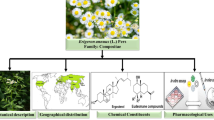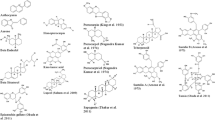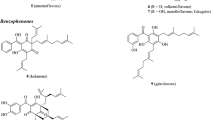Abstract
Phyllanthus emblica L. (syn. Emblica officinalis) is commonly known as Indian gooseberry. In Ayurveda, P. emblica has been extensively used, both as edible (tonic) plants and for its therapeutic potentials. P. emblica is highly nutritious and is reported as an important dietary source of vitamin C, minerals and amino acids. All parts of the plant are used for medicinal purposes, especially the fruit, which has been used in Ayurveda as a potent Rasayana (rejuvenator). P. emblica contains phytochemicals including fixed oils, phosphatides, essential oils, tannins, minerals, vitamins, amino acids, fatty acids, glycosides, etc. Various pharmaceutical potential of P. emblica has been reported previously including antimicrobial, antioxidant, anti-inflammatory, analgesic and antipyretic, adaptogenic, hepatoprotective, antitumor and antiulcerogenic activities either in combined formulation or P. emblica alone. The various other Ayurvedic potentials of P. emblica are yet to be proven scientifically in order to explore its broad spectrum of therapeutic effects. On this regards we, in this review, tried to explore the complete information of P. emblica including its pharmacognosy, phytochemistry and pharmacology.
Similar content being viewed by others
References
Unander DW, Webster GL, Blumberg BS. Usage and bioassays in Phyllanthus (Euphorbiaceae). IV. Clustering of antiviral uses and other effects. J Ethnopharmacol 1995;45:1–18.
Unander DW, Webster GL, Blumberg BS. Records of usage or assays in Phyllanthus (Euphorbiaceae). I. Subgenera Isocladus, Kirganelia, Cicca and Emblica. J Ethnopharmacol 1990;30:233–264.
Kirtikar KR, Basu BD. Terminalia chebula in Indian medicinal plants-2. 1935;1:1020–1023.
Calixto JB, Santos AR, Cechinel Filho V, Yunes RA. A review of the plants of the genus Phyllanthus: their chemistry, pharmacology, and therapeutic potential. Med Res Rev 1998;18:225–258.
Vasudevan M, Parle M. Effect of Anwala churna (Emblica officinalis Gaertn.): an ayurvedic preparation on memory deficit rats. J Pharm Soc Jpn 2007;127:1701–1707.
Ojha JK. Chyawanprash from Vedic to Genomic Era. 2003.
Zhang YJ, Tanaka T, Iwamoto Y, Yang CR, Kouno I. Novel norsesquiterpenoids from the roots of Phyllanthus emblica. J Nat Prod 2000;63:1507–1510.
Bhattacharya A, Ghosal S, Bhattacharya SK. Antioxidant activity of tannoid principles of Emblica officinalis (amla) in chronic stress induced changes in rat brain. Ind J Exp Biol 2000;38:877–880.
Ahmad I, Mehmood Z, Mohammad F. Screening of some Indian medicinal plants for their antimicrobial properties. J Ethnopharmacol 1998;62:183–193.
Chatterjee UR, Bandyopadhyay SS, Ghosh D, Ghosal PK, Ray B. In vitro anti-oxidant activity, fluorescence quenching study and structural features of carbohydrate polymers from Phyllanthus emblica. Int J Biol Macromol 2011;49:637–642.
Sumitra M, Manikandan P, Gayathri VS, Mahendran P, Suguna L. Emblica officinalis exerts wound healing action through up-regulation of collagen and extracellular signal-regulated kinases (ERK1/2). Wound Repair Regen 2009;17:99–107.
Golechha M, Bhatia J, Ojha S, Arya DS. Hydroalcoholic extract of Emblica officinalis protects against kainic acid-induced status epilepticus in rats: evidence for an antioxidant, anti-inflammatory, and neuroprotective intervention. Pharm Biol 2011;49:1128–1136.
Mythilypriya R, Shanthi P, Sachdanandam P. Analgesic, antipyretic and ulcerogenic properties of an indigenous formulation—Kalpaamruthaa. Phytother Res 2007;21:574–578.
Perianayagam JB, Sharma SK, Joseph A, Christina AJ. Evaluation of anti-pyretic and analgesic activity of Emblica officinalis Gaertn. J Ethnopharmacol 2004;95:83–85.
Baliga MS, Meera S, Mathai B, Rai MP, Pawar V, Palatty PL. Scientific validation of the ethnomedicinal properties of the Ayurvedic drug Triphala: a review. Chin J Integr Med 2012;18:946–954.
Gulati RK, Agarwal S, Agrawal SS. Hepatoprotective studies on Phyllanthus emblica Linn. and quercetin. Ind J Exp Biol 1995;33:261–268.
Suresh K, Vasudevan DM. Augmentation of murine natural killer cell and antibody dependent cellular cytotoxicity activities by Phyllanthus emblica, a new immunomodulator. J Ethnopharmacol 1994;44:55–60.
Sairam K, Rao Ch V, Babu MD, Kumar KV, Agrawal VK, RK KG. Antiulcerogenic effect of methanolic extract of Emblica officinalis: an experimental study. J Ethnopharmacol 2002;82:1–9.
Ashokkumar D. Pharmacognostical investigations on Triphala churnam. Anc Sci Life 2007;26:40–44.
Sandhya T, Lathika KM, Pandey BN, Mishra KP. Potential of traditional Ayurvedic formulation, Triphala, as a novel anticancer drug. Cancer Lett 2006;231:206–214.
Xia Q, Xiao P, Wan L, Kong J. Ethnopharmacology of Phyllanthus emblica L. Chin J Chin Mater Med (Chin) 1997;22:515–518,525,574.
Murthy ZVP, Joshi D. Fluidized bed drying of aonla (Emblica officinalis). Drying Technol 2007;25:883–889.
Zhang YJ, Tanaka T, Iwamoto Y, Yang CR, Kouno I. Phyllaemblic acid, a novel highly oxygenated norbisabolane from the roots of Phyllanthus emblica. Tetrahedron Lett 2000;41:1781–1784.
Ganesan R. Identification, distribution and conservation of Phyllanthus indofischeri, another source of Indian gooseberry. Curr Sci 2003;84:1515–1518.
Sangeetha N, Mercy S, Kavitha M, Selvaraj D, Sathishkumar R, Ganesh D. Morphological variation in the Indian gooseberries (Phyllanthus emblica and Phyllanthus indofischeri) and the chloroplast trnL (UAA) intron as candidate gene for their identification. Plant Genet Resources 2010;8:191–197.
Arora D SR, Sharma S, Suttee A. Phytochemical and microscopical investigations on Emblica officinalis Gaertn. Int J Pharmac Phytoch Res 2012;4:1–4.
Scartezzini P, Speroni E. Review on some plants of Indian traditional medicine with antioxidant activity. J Ethnopharmacol 2000;71:23–43.
Morton J. The Emblic (Phyllanthus emblica L.). Economic Botany 1960;14:119–128.
Krishnaveni M, Mirunalini S. Therapeutic potential of Phyllanthus emblica (amla): the ayurvedic wonder. J Basic Clin Physiol Pharmacol 2010;21:93–105.
Thakur CP. emblica officinalis reduces serum, aortic and hepatic cholesterol in rabbits. Experientia 1985;41:423–424.
Yokozawa T, Kim HY, Kim HJ, Okubo T, Chu DC, Juneja LR. Amla (Emblica officinalis Gaertn.) prevents dyslipidaemia and oxidative stress in the ageing process. Br J Nutr 2007;97:1187–1195.
Ishtiaq M, Hanif W, Khan MA, Ashraf M, Butt AM. An ethnomedicinal survey and documentation of important medicinal folklore food phytonims of flora of Samahni valley, (Azad Kashmir) Pakistan. Pak J Biol Sci 2007;10:2241–2256.
Shanmugasundaram KR, Seethapathy PG, Shanmugasundaram ER. Anna Pavala Sindhooram—an antiatherosclerotic Indian drug. J Ethnopharmacol 1983;7:247–265.
Habibur R, Yasin KA, Choudhary MA, Khaliq N, Attaur R, Choudhary MI, et al. Studies on the chemical constituents of Phyllanthus emblica. Nat Prod Res 2007;21:775–781.
Bhattacharya A, Chatterjee A, Ghosal S, Bhattacharya SK. Antioxidant activity of active tannoid principles of Emblica officinalis (amla). Indian J Exp Biol 1999;37:676–680.
Naik GH, Priyadarsini KI, Bhagirathi RG, Mishra B, Mishra KP, Banavalikar MM, et al. In vitro antioxidant studies and free radical reactions of triphala, an ayurvedic formulation and its constituents. Phytother Res 2005;19:582–586.
Zhang LZ, Zhao WH, Guo YJ, Tu GZ, Lin S, Xin LG. Studies on chemical constituents in fruits of Tibetan medicine Phyllanthus emblica. China J Chin Mater Med (Chin) 2003;28:940–943.
Zhang YJ, Nagao T, Tanaka T, Yang CR, Okabe H, Kouno I. Antiproliferative activity of the main constituents from Phyllanthus emblica. Biol Pharm Bull 2004;27:251–255.
Kumar A, Tantry BA, Rahiman S, Gupta U. Comparative study of antimicrobial activity and phytochemical analysis of methanolic and aqueous extracts of the fruit of Emblica officinalis against pathogenic bacteria. J Tradit Chin Med 2011;31:246–250.
Saeed S, Tariq P. Antibacterial activities of Emblica officinalis and Coriandrum sativum against Gram negative urinary pathogens. Pak J Pharm Sci 2007;20:32–35.
Xiang Y, Pei Y, Qu C, Lai Z, Ren Z, Yang K, et al. In vitro anti-herpes simplex virus activity of 1,2,4,6-tetra-O-galloyl-beta-D-glucose from Phyllanthus emblica L. (Euphorbiaceae). Phytother Res 2011;25:975–982.
Bagavan A, Rahuman AA, Kaushik NK, Sahal D. In vitro antimalarial activity of medicinal plant extracts against Plasmodium falciparum. Parasitol Res 2011;108:15–22.
Rahman S, Akbor MM, Howlader A, Jabbar A. Antimicrobial and cytotoxic activity of the alkaloids of Amlaki (Emblica officinalis). Pak J Biol Sci 2009;12:1152–1155.
Poltanov EA, Shikov AN, Dorman HJ, Pozharitskaya ON, Makarov VG, Tikhonov VP, et al. Chemical and antioxidant evaluation of Indian gooseberry (Emblica officinalis Gaertn., syn. Phyllanthus emblica L.) supplements. Phytother Res 2009;23:1309–1315.
Saito K, Kohno M, Yoshizaki F, Niwano Y. Extensive screening for edible herbal extracts with potent scavenging activity against superoxide anions. Plant Foods Hum Nutr 2008;63:65–70.
Kumaran A, Karunakaran RJ. Nitric oxide radical scavenging active components from Phyllanthus emblica L. Plant Foods Hum Nutr 2006;61:1–5.
Scartezzini P, Antognoni F, Raggi MA, Poli F, Sabbioni C. Vitamin C content and antioxidant activity of the fruit and of the Ayurvedic preparation of Emblica officinalis Gaertn. J Ethnopharmacol 2006;104:113–118.
Mehmood MH, Rehman A, Najeeb Ur R, Gilani AH. Studies on prokinetic, laxative and spasmodic activities of Phyllanthus emblica in experimental animals. Phytother Res 2012;27:1054–1060.
Nain P, Saini V, Sharma S, Nain J. Antidiabetic and antioxidant potential of Emblica officinalis Gaertn. leaves extract in streptozotocin-induced type 2 diabetes mellitus (T2DM) rats. J Ethnopharmacol 2012;142:65–71.
Suryanarayana P, Saraswat M, Petrash JM, Reddy GB. Emblica officinalis and its enriched tannoids delay streptozotocin-induced diabetic cataract in rats. Mol Vis 2007;13:1291–1297.
Mehmood MH, Siddiqi HS, Gilani AH. The antidiarrheal and spasmolytic activities of Phyllanthus emblica are mediated through dual blockade of muscarinic receptors and Ca2+ channels. J Ethnopharmacol 2011;133:856–865.
Pratibha N, Saxena VS, Amit A, D’Souza P, Bagchi M, Bagchi D. Anti-inflammatory activities of Aller-7, a novel polyherbal formulation for allergic rhinitis. Int J Tissue React 2004;26:43–51.
Bandyopadhyay SK, Pakrashi SC, Pakrashi A. The role of antioxidant activity of Phyllanthus emblica fruits on prevention from indomethacin induced gastric ulcer. J Ethnopharmacol 2000;70:171–176.
Jacob A, Pandey M, Kapoor S, Saroja R. Effect of the Indian gooseberry (amla) on serum cholesterol levels in men aged 35-55 years. Eur J Clin Nutr 1988;42:939–944.
Kim HJ, Yokozawa T, Kim HY, Tohda C, Rao TP, Juneja LR. Influence of amla (Emblica officinalis Gaertn.) on hypercholesterolemia and lipid peroxidation in cholesterolfed rats. J Nutr Sci Vitaminol (Tokyo) 2005;51:413–418.
Duan W, Yu Y, Zhang L. Antiatherogenic effects of phyllanthus emblica associated with corilagin and its analogue. J Pharm Soc Jpn 2005;125:587–591.
Mathur R, Sharma A, Dixit VP, Varma M. Hypolipidaemic effect of fruit juice of Emblica officinalis in cholesterol-fed rabbits. J Ethnopharmacol 1996;50:61–68.
Lee CY, Peng WH, Cheng HY, Chen FN, Lai MT, Chiu TH. Hepatoprotective effect of Phyllanthus in Taiwan on acute liver damage induced by carbon tetrachloride. Am J Chin Med 2006;34:471–482.
Chatterjee A, Chattopadhyay S, Bandyopadhyay SK. Biphasic Effect of Phyllanthus emblica L. extract on NSAID-induced ulcer: an antioxidative trail weaved with immunomodulatory effect. Evid Based Complement Alternat Med 2011;2011:146808.
Bhattacharya SK, Bhattacharya A, Sairam K, Ghosal S. Effect of bioactive tannoid principles of Emblica officinalis on ischemia-reperfusion-induced oxidative stress in rat heart. Phytomedicine 2002;9:171–174.
Ngamkitidechaku lC, Jaijoy K, Hansaku lP, Soonthornchareonnon N, Sireeratawong S. Antitumour effects of Phyllanthus emblica L.: induction of cancer cell apoptosis and inhibition of in vivo tumour promotion and in vitro invasion of human cancer cells. Phytother Res 2010;24:1405–1413.
Jose JK, Kuttan G, Kuttan R. Antitumour activity of Emblica officinalis. J Ethnopharmacol 2001;75:65–69.
Nosal’ova G, Mokry J, Hassan KM. Antitussive activity of the fruit extract of Emblica officinalis Gaertn. (Euphorbiaceae). Phytomedicine 2003;10:583–589.
Sumantran VN, Kulkarni A, Chandwaskar R, Harsulkar A, Patwardhan B, Chopra A, et al. Chondroprotective potential of fruit extracts of Phyllanthus emblica in osteoarthritis. Evid Based Complement Alternat Med 2008;5:329–335.
Singh E SS, Pareek A, Dwivedi J, Yadav S, Sharma. Phytochemistry, traditional uses and cancer chemopreventive activity of amla (Phyllanthus emblica): The Sustainer. J Appl Pharmac Sci 2012;2:176–183.
Qi WY, Li Y, Hua L, Wang K, Gao K. Cytotoxicity and structure activity relationships of phytosterol from Phyllanthus emblica. Fitoterapia 2012;84C:252–256.
Author information
Authors and Affiliations
Corresponding author
Rights and permissions
About this article
Cite this article
Gaire, B.P., Subedi, L. Phytochemistry, pharmacology and medicinal properties of Phyllanthus emblica Linn.. Chin. J. Integr. Med. (2014). https://doi.org/10.1007/s11655-014-1984-2
Received:
Published:
DOI: https://doi.org/10.1007/s11655-014-1984-2




